wheel FIAT DUCATO BASE CAMPER 2015 Owner handbook (in English)
[x] Cancel search | Manufacturer: FIAT, Model Year: 2015, Model line: DUCATO BASE CAMPER, Model: FIAT DUCATO BASE CAMPER 2015Pages: 367, PDF Size: 19.73 MB
Page 94 of 367
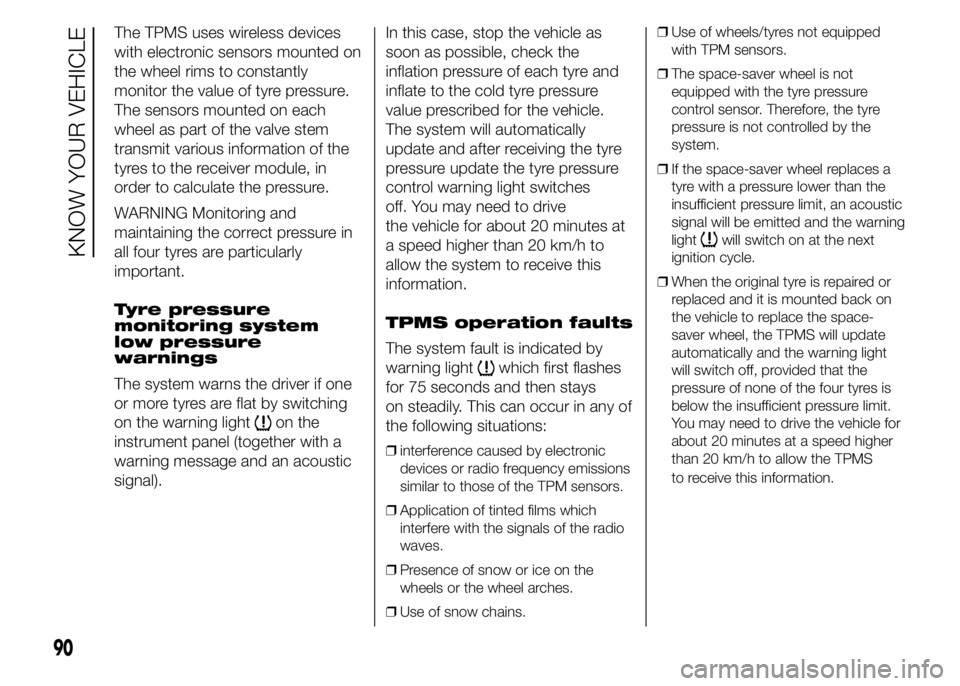
The TPMS uses wireless devices
with electronic sensors mounted on
the wheel rims to constantly
monitor the value of tyre pressure.
The sensors mounted on each
wheel as part of the valve stem
transmit various information of the
tyres to the receiver module, in
order to calculate the pressure.
WARNING Monitoring and
maintaining the correct pressure in
all four tyres are particularly
important.
Tyre pressure
monitoring system
low pressure
warnings
The system warns the driver if one
or more tyres are flat by switching
on the warning light
on the
instrument panel (together with a
warning message and an acoustic
signal).In this case, stop the vehicle as
soon as possible, check the
inflation pressure of each tyre and
inflate to the cold tyre pressure
value prescribed for the vehicle.
The system will automatically
update and after receiving the tyre
pressure update the tyre pressure
control warning light switches
off. You may need to drive
the vehicle for about 20 minutes at
a speed higher than 20 km/h to
allow the system to receive this
information.
TPMS operation faults
The system fault is indicated by
warning light
which first flashes
for 75 seconds and then stays
on steadily. This can occur in any of
the following situations:
❒interference caused by electronic
devices or radio frequency emissions
similar to those of the TPM sensors.
❒Application of tinted films which
interfere with the signals of the radio
waves.
❒Presence of snow or ice on the
wheels or the wheel arches.
❒Use of snow chains.❒Use of wheels/tyres not equipped
with TPM sensors.
❒The space-saver wheel is not
equipped with the tyre pressure
control sensor. Therefore, the tyre
pressure is not controlled by the
system.
❒If the space-saver wheel replaces a
tyre with a pressure lower than the
insufficient pressure limit, an acoustic
signal will be emitted and the warning
light
will switch on at the next
ignition cycle.
❒When the original tyre is repaired or
replaced and it is mounted back on
the vehicle to replace the space-
saver wheel, the TPMS will update
automatically and the warning light
will switch off, provided that the
pressure of none of the four tyres is
below the insufficient pressure limit.
You may need to drive the vehicle for
about 20 minutes at a speed higher
than 20 km/h to allow the TPMS
to receive this information.
90
KNOW YOUR VEHICLE
Page 95 of 367
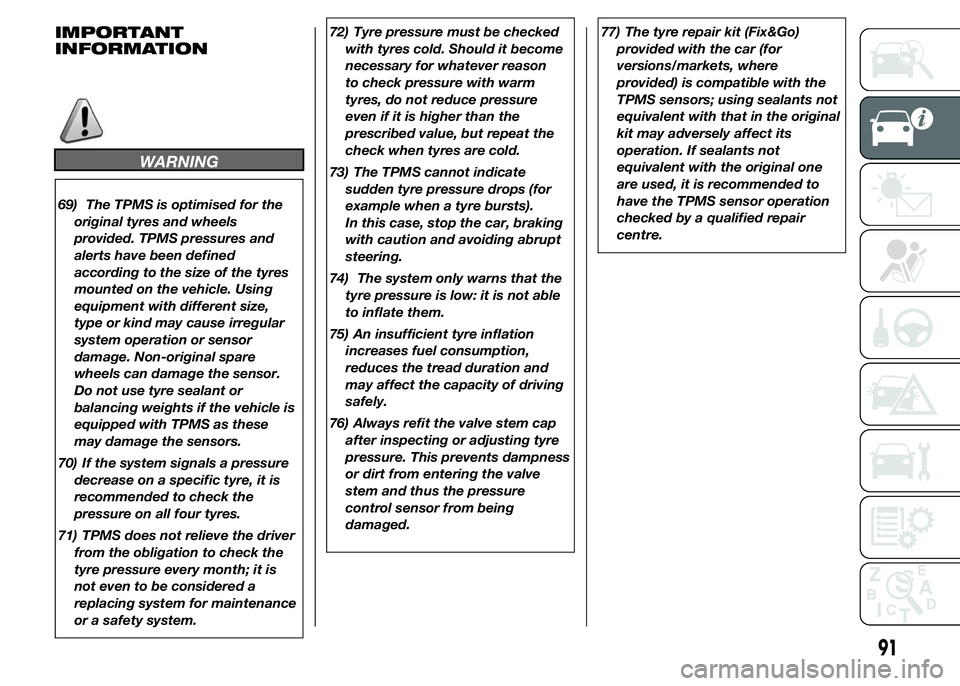
IMPORTANT
INFORMATION
WARNING
69) The TPMS is optimised for the
original tyres and wheels
provided. TPMS pressures and
alerts have been defined
according to the size of the tyres
mounted on the vehicle. Using
equipment with different size,
type or kind may cause irregular
system operation or sensor
damage. Non-original spare
wheels can damage the sensor.
Do not use tyre sealant or
balancing weights if the vehicle is
equipped with TPMS as these
may damage the sensors.
70) If the system signals a pressure
decrease on a specific tyre, it is
recommended to check the
pressure on all four tyres.
71) TPMS does not relieve the driver
from the obligation to check the
tyre pressure every month; it is
not even to be considered a
replacing system for maintenance
or a safety system.72) Tyre pressure must be checked
with tyres cold. Should it become
necessary for whatever reason
to check pressure with warm
tyres, do not reduce pressure
even if it is higher than the
prescribed value, but repeat the
check when tyres are cold.
73) The TPMS cannot indicate
sudden tyre pressure drops (for
example when a tyre bursts).
In this case, stop the car, braking
with caution and avoiding abrupt
steering.
74) The system only warns that the
tyre pressure is low: it is not able
to inflate them.
75) An insufficient tyre inflation
increases fuel consumption,
reduces the tread duration and
may affect the capacity of driving
safely.
76) Always refit the valve stem cap
after inspecting or adjusting tyre
pressure. This prevents dampness
or dirt from entering the valve
stem and thus the pressure
control sensor from being
damaged.77) The tyre repair kit (Fix&Go)
provided with the car (for
versions/markets, where
provided) is compatible with the
TPMS sensors; using sealants not
equivalent with that in the original
kit may adversely affect its
operation. If sealants not
equivalent with the original one
are used, it is recommended to
have the TPMS sensor operation
checked by a qualified repair
centre.
91
Page 113 of 367
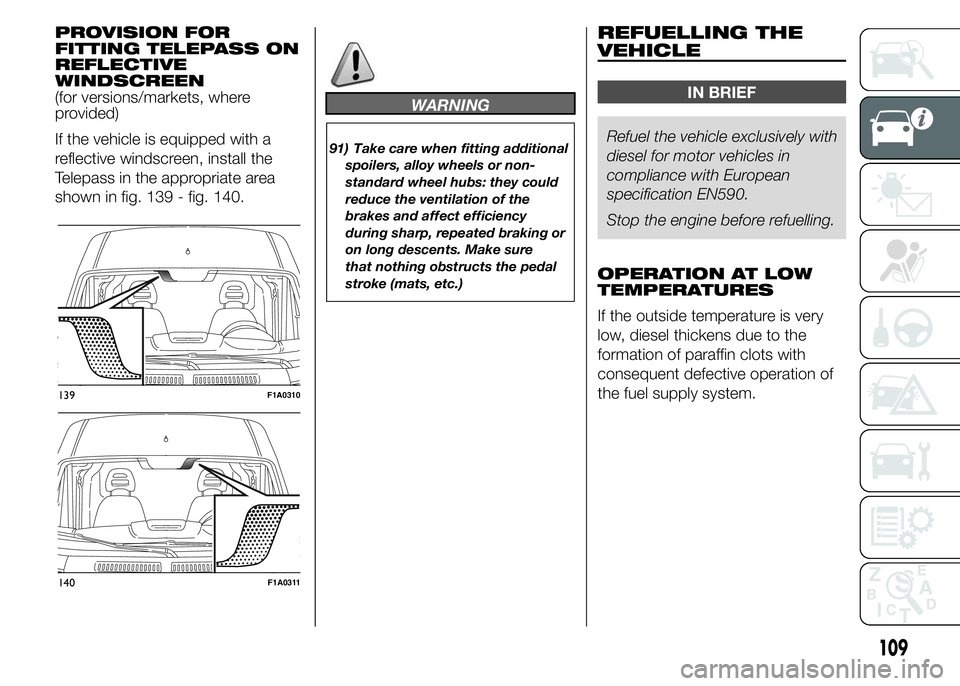
PROVISION FOR
FITTING TELEPASS ON
REFLECTIVE
WINDSCREEN
(for versions/markets, where
provided)
If the vehicle is equipped with a
reflective windscreen, install the
Telepass in the appropriate area
shown in fig. 139 - fig. 140.
WARNING
91) Take care when fitting additional
spoilers, alloy wheels or non-
standard wheel hubs: they could
reduce the ventilation of the
brakes and affect efficiency
during sharp, repeated braking or
on long descents. Make sure
that nothing obstructs the pedal
stroke (mats, etc.)
REFUELLING THE
VEHICLE
IN BRIEF
Refuel the vehicle exclusively with
diesel for motor vehicles in
compliance with European
specification EN590.
Stop the engine before refuelling.
OPERATION AT LOW
TEMPERATURES
If the outside temperature is very
low, diesel thickens due to the
formation of paraffin clots with
consequent defective operation of
the fuel supply system.
139F1A0310
140F1A0311
109
Page 137 of 367
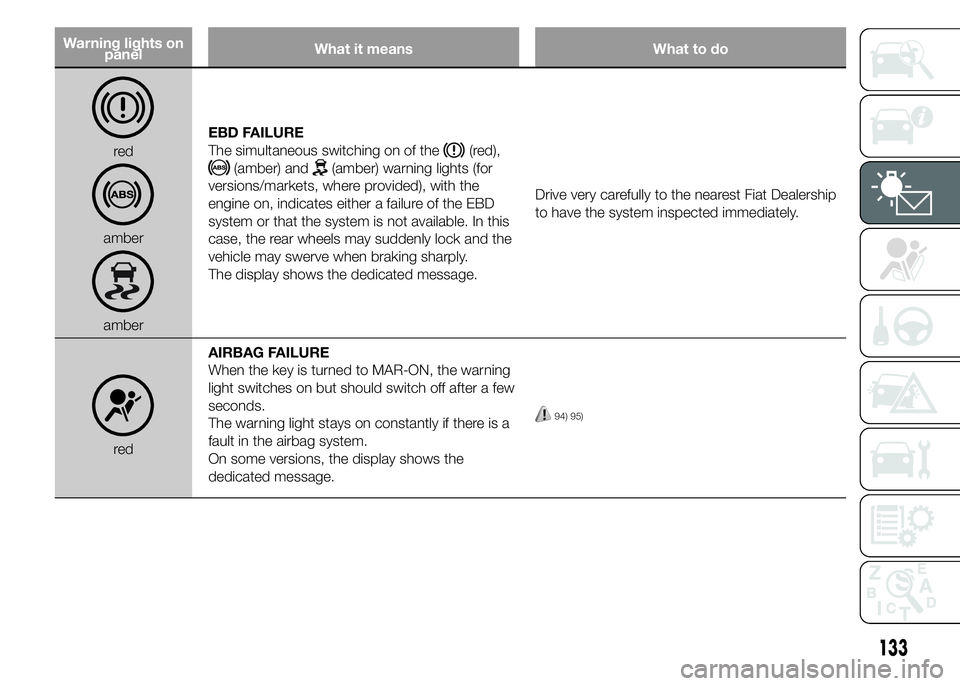
Warning lights on
panelWhat it means What to do
red
amber
amberEBD FAILURE
The simultaneous switching on of the
(red),
(amber) and(amber) warning lights (for
versions/markets, where provided), with the
engine on, indicates either a failure of the EBD
system or that the system is not available. In this
case, the rear wheels may suddenly lock and the
vehicle may swerve when braking sharply.
The display shows the dedicated message.Drive very carefully to the nearest Fiat Dealership
to have the system inspected immediately.
redAIRBAG FAILURE
When the key is turned to MAR-ON, the warning
light switches on but should switch off after a few
seconds.
The warning light stays on constantly if there is a
fault in the airbag system.
On some versions, the display shows the
dedicated message.
94) 95)
133
Page 141 of 367
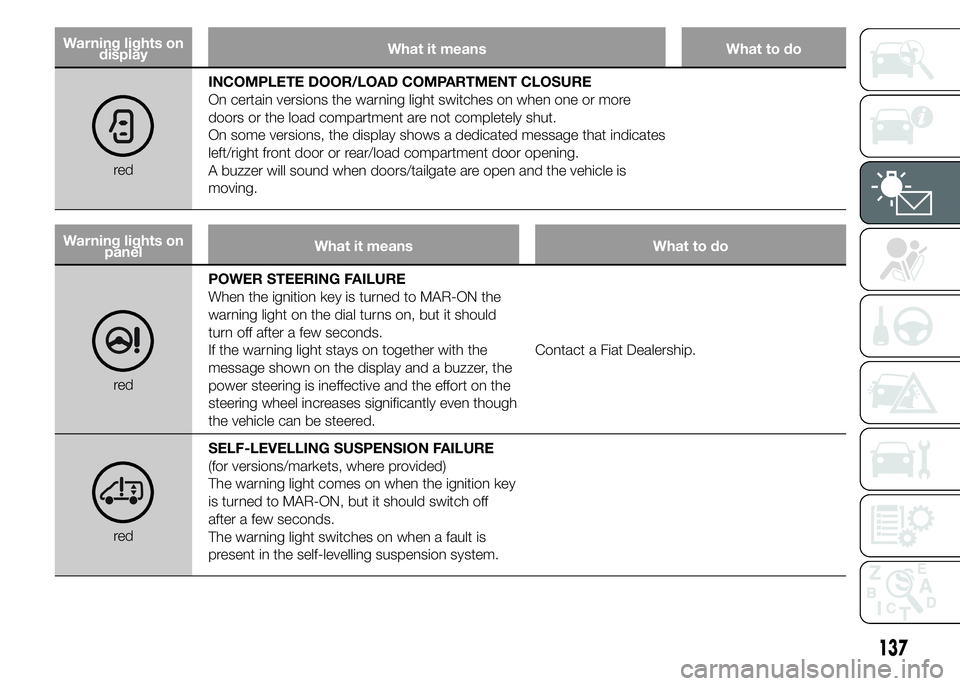
Warning lights on
displayWhat it means What to do
redINCOMPLETE DOOR/LOAD COMPARTMENT CLOSURE
On certain versions the warning light switches on when one or more
doors or the load compartment are not completely shut.
On some versions, the display shows a dedicated message that indicates
left/right front door or rear/load compartment door opening.
A buzzer will sound when doors/tailgate are open and the vehicle is
moving.
Warning lights on
panelWhat it means What to do
redPOWER STEERING FAILURE
When the ignition key is turned to MAR-ON the
warning light on the dial turns on, but it should
turn off after a few seconds.
If the warning light stays on together with the
message shown on the display and a buzzer, the
power steering is ineffective and the effort on the
steering wheel increases significantly even though
the vehicle can be steered.Contact a Fiat Dealership.
redSELF-LEVELLING SUSPENSION FAILURE
(for versions/markets, where provided)
The warning light comes on when the ignition key
is turned to MAR-ON, but it should switch off
after a few seconds.
The warning light switches on when a fault is
present in the self-levelling suspension system.
137
Page 174 of 367
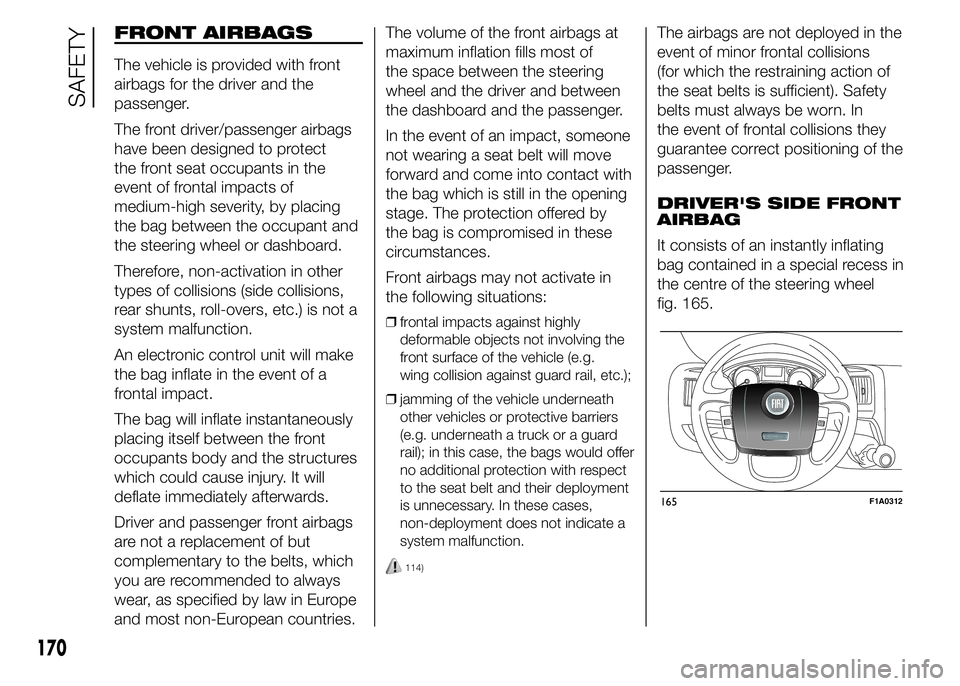
FRONT AIRBAGS
The vehicle is provided with front
airbags for the driver and the
passenger.
The front driver/passenger airbags
have been designed to protect
the front seat occupants in the
event of frontal impacts of
medium-high severity, by placing
the bag between the occupant and
the steering wheel or dashboard.
Therefore, non-activation in other
types of collisions (side collisions,
rear shunts, roll-overs, etc.) is not a
system malfunction.
An electronic control unit will make
the bag inflate in the event of a
frontal impact.
The bag will inflate instantaneously
placing itself between the front
occupants body and the structures
which could cause injury. It will
deflate immediately afterwards.
Driver and passenger front airbags
are not a replacement of but
complementary to the belts, which
you are recommended to always
wear, as specified by law in Europe
and most non-European countries.The volume of the front airbags at
maximum inflation fills most of
the space between the steering
wheel and the driver and between
the dashboard and the passenger.
In the event of an impact, someone
not wearing a seat belt will move
forward and come into contact with
the bag which is still in the opening
stage. The protection offered by
the bag is compromised in these
circumstances.
Front airbags may not activate in
the following situations:
❒frontal impacts against highly
deformable objects not involving the
front surface of the vehicle (e.g.
wing collision against guard rail, etc.);
❒jamming of the vehicle underneath
other vehicles or protective barriers
(e.g. underneath a truck or a guard
rail); in this case, the bags would offer
no additional protection with respect
to the seat belt and their deployment
is unnecessary. In these cases,
non-deployment does not indicate a
system malfunction.
114)
The airbags are not deployed in the
event of minor frontal collisions
(for which the restraining action of
the seat belts is sufficient). Safety
belts must always be worn. In
the event of frontal collisions they
guarantee correct positioning of the
passenger.
DRIVER'S SIDE FRONT
AIRBAG
It consists of an instantly inflating
bag contained in a special recess in
the centre of the steering wheel
fig. 165.
165F1A0312
170
SAFETY
Page 178 of 367

WARNING
114) Do not apply stickers or other objects to the steering wheel, the dashboard in the passenger side airbag area and
the seats. Never put objects (e.g. mobile phones) on the passenger side of the dashboard since they could interfere
with correct inflation of the passenger airbag and also cause serious injury to the passengers.
115) When an active passenger airbag is fitted, DO NOT install rear facing child restraint systems on the front seat.
Deployment of the airbag in an accident could cause fatal injuries to the child regardless of the severity of the
impact. Therefore, always deactivate the passenger airbag when a rear facing child restraint system is installed on
the front passenger seat. The front passenger seat must also be positioned back as far as possible in order to prevent
the child restraint system from coming into contact with the dashboard. Immediately reactivate the passenger airbag
as soon as the child restraint system has been removed.
174
SAFETY
Page 181 of 367
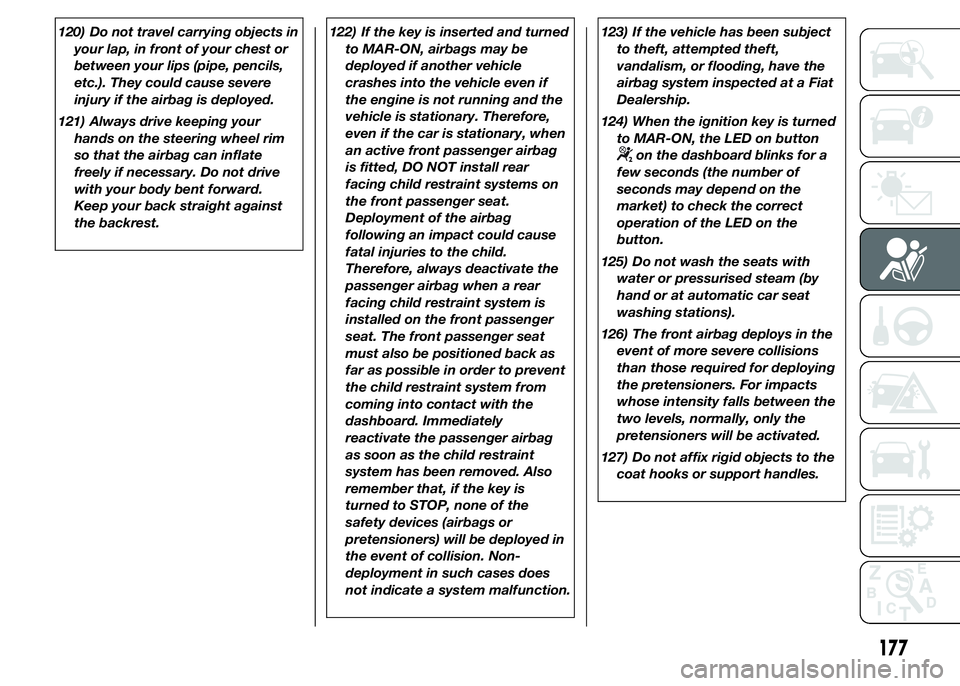
120) Do not travel carrying objects in
your lap, in front of your chest or
between your lips (pipe, pencils,
etc.). They could cause severe
injury if the airbag is deployed.
121) Always drive keeping your
hands on the steering wheel rim
so that the airbag can inflate
freely if necessary. Do not drive
with your body bent forward.
Keep your back straight against
the backrest.122) If the key is inserted and turned
to MAR-ON, airbags may be
deployed if another vehicle
crashes into the vehicle even if
the engine is not running and the
vehicle is stationary. Therefore,
even if the car is stationary, when
an active front passenger airbag
is fitted, DO NOT install rear
facing child restraint systems on
the front passenger seat.
Deployment of the airbag
following an impact could cause
fatal injuries to the child.
Therefore, always deactivate the
passenger airbag when a rear
facing child restraint system is
installed on the front passenger
seat. The front passenger seat
must also be positioned back as
far as possible in order to prevent
the child restraint system from
coming into contact with the
dashboard. Immediately
reactivate the passenger airbag
as soon as the child restraint
system has been removed. Also
remember that, if the key is
turned to STOP, none of the
safety devices (airbags or
pretensioners) will be deployed in
the event of collision. Non-
deployment in such cases does
not indicate a system malfunction.123) If the vehicle has been subject
to theft, attempted theft,
vandalism, or flooding, have the
airbag system inspected at a Fiat
Dealership.
124) When the ignition key is turned
to MAR-ON, the LED on button
on the dashboard blinks for a
few seconds (the number of
seconds may depend on the
market) to check the correct
operation of the LED on the
button.
125) Do not wash the seats with
water or pressurised steam (by
hand or at automatic car seat
washing stations).
126) The front airbag deploys in the
event of more severe collisions
than those required for deploying
the pretensioners. For impacts
whose intensity falls between the
two levels, normally, only the
pretensioners will be activated.
127) Do not affix rigid objects to the
coat hooks or support handles.
177
Page 185 of 367
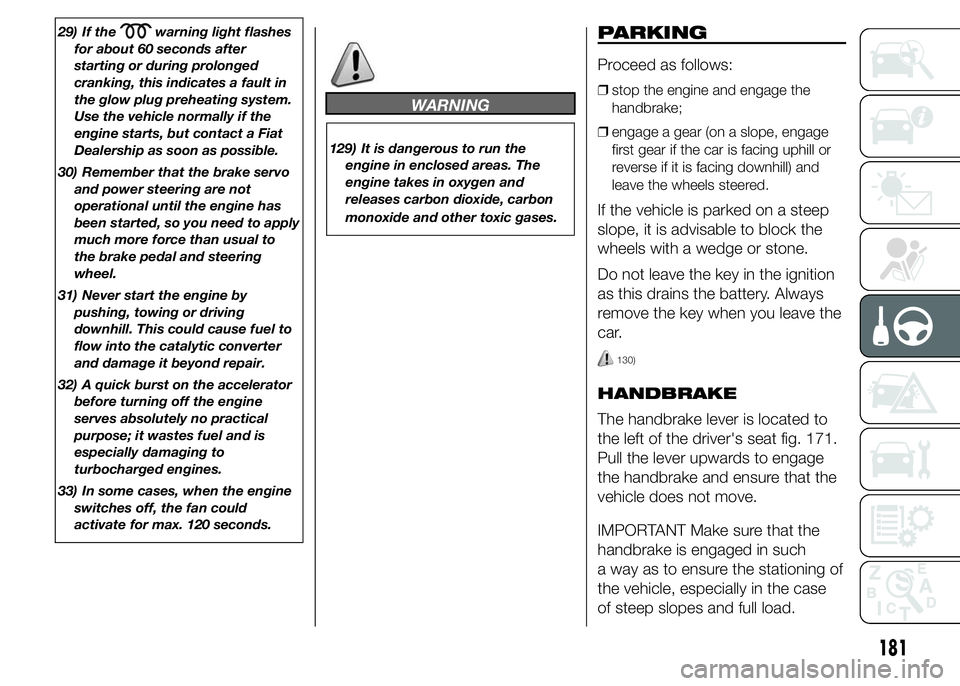
29) If thewarning light flashes
for about 60 seconds after
starting or during prolonged
cranking, this indicates a fault in
the glow plug preheating system.
Use the vehicle normally if the
engine starts, but contact a Fiat
Dealership as soon as possible.
30) Remember that the brake servo
and power steering are not
operational until the engine has
been started, so you need to apply
much more force than usual to
the brake pedal and steering
wheel.
31) Never start the engine by
pushing, towing or driving
downhill. This could cause fuel to
flow into the catalytic converter
and damage it beyond repair.
32) A quick burst on the accelerator
before turning off the engine
serves absolutely no practical
purpose; it wastes fuel and is
especially damaging to
turbocharged engines.
33) In some cases, when the engine
switches off, the fan could
activate for max. 120 seconds.
WARNING
129) It is dangerous to run the
engine in enclosed areas. The
engine takes in oxygen and
releases carbon dioxide, carbon
monoxide and other toxic gases.
PARKING
Proceed as follows:
❒stop the engine and engage the
handbrake;
❒engage a gear (on a slope, engage
first gear if the car is facing uphill or
reverse if it is facing downhill) and
leave the wheels steered.
If the vehicle is parked on a steep
slope, it is advisable to block the
wheels with a wedge or stone.
Do not leave the key in the ignition
as this drains the battery. Always
remove the key when you leave the
car.
130)
HANDBRAKE
The handbrake lever is located to
the left of the driver's seat fig. 171.
Pull the lever upwards to engage
the handbrake and ensure that the
vehicle does not move.
IMPORTANT Make sure that the
handbrake is engaged in such
a way as to ensure the stationing of
the vehicle, especially in the case
of steep slopes and full load.
181
Page 192 of 367
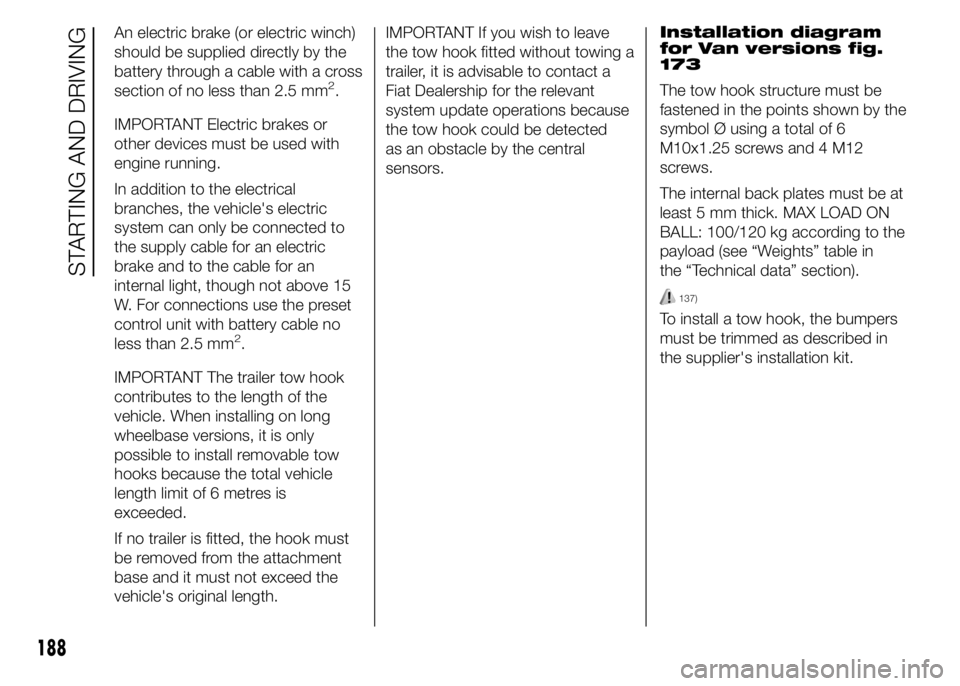
An electric brake (or electric winch)
should be supplied directly by the
battery through a cable with a cross
section of no less than 2.5 mm
2.
IMPORTANT Electric brakes or
other devices must be used with
engine running.
In addition to the electrical
branches, the vehicle's electric
system can only be connected to
the supply cable for an electric
brake and to the cable for an
internal light, though not above 15
W. For connections use the preset
control unit with battery cable no
less than 2.5 mm
2.
IMPORTANT The trailer tow hook
contributes to the length of the
vehicle. When installing on long
wheelbase versions, it is only
possible to install removable tow
hooks because the total vehicle
length limit of 6 metres is
exceeded.
If no trailer is fitted, the hook must
be removed from the attachment
base and it must not exceed the
vehicle's original length.IMPORTANT If you wish to leave
the tow hook fitted without towing a
trailer, it is advisable to contact a
Fiat Dealership for the relevant
system update operations because
the tow hook could be detected
as an obstacle by the central
sensors.Installation diagram
for Van versions fig.
173
The tow hook structure must be
fastened in the points shown by the
symbol Ø using a total of 6
M10x1.25 screws and 4 M12
screws.
The internal back plates must be at
least 5 mm thick. MAX LOAD ON
BALL: 100/120 kg according to the
payload (see “Weights” table in
the “Technical data” section).
137)
To install a tow hook, the bumpers
must be trimmed as described in
the supplier's installation kit.
188
STARTING AND DRIVING